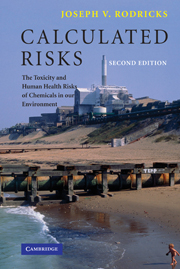Book contents
- Frontmatter
- Contents
- Preface to the first edition
- Preface to the second edition
- List of abbreviations
- Prologue
- 1 Chemicals and chemical exposures
- 2 From exposure to dose
- 3 From dose to toxic response
- 4 Toxic agents and their targets
- 5 Carcinogens
- 6 Identifying carcinogens
- 7 Risk assessment I: some concepts and principles
- 8 Risk assessment II: applications
- 9 Risk assessment III: new approaches, new problems
- 10 Risk assessment IV: the courtroom
- 11 The management of risk
- 12 A look ahead
- Sources and recommended reading
- Index
Preface to the first edition
Published online by Cambridge University Press: 25 August 2009
- Frontmatter
- Contents
- Preface to the first edition
- Preface to the second edition
- List of abbreviations
- Prologue
- 1 Chemicals and chemical exposures
- 2 From exposure to dose
- 3 From dose to toxic response
- 4 Toxic agents and their targets
- 5 Carcinogens
- 6 Identifying carcinogens
- 7 Risk assessment I: some concepts and principles
- 8 Risk assessment II: applications
- 9 Risk assessment III: new approaches, new problems
- 10 Risk assessment IV: the courtroom
- 11 The management of risk
- 12 A look ahead
- Sources and recommended reading
- Index
Summary
Think how many carcinogens are household names: asbestos, cigarette smoke (a mixture of several thousand chemical compounds), DES, dioxin, saccharin, arsenic, PCBs, radon, EDB, Alar. Hundreds more of these substances, some very obscure, are known to the scientific and medical community, and many of these are scattered throughout the land at thousands of hazardous waste sites similar to Love Canal. People are exposed to these dreadful substances through the air they breathe, the water they drink and bathe in, and the foods they eat. Chemicals can also produce many other types of health damage, some very serious, such as birth defects and damage to our nervous and immune systems.
The chemical accident at Bhopal, India, in late 1984, is only the worst example of events that take place almost daily, on a smaller scale, throughout the world. Human beings are not the only potential victims of chemical toxicity – all of life on earth can be affected. Chemicals are ravaging human health and the environment, and conditions are worsening.
But wait. Let's remember that chemicals have virtually transformed the modern world in extraordinarily beneficial ways. During the past 100 years the chemical industry has offered up, and we have eagerly consumed, thousands of highly useful materials and products. Among these products are many that have had profoundly beneficial effects on human health – antibiotics and other remarkable medicinal agents to prevent and cure diseases, pesticides to protect crops, preservatives to protect the food supply, plastics, fibers, metals and hundreds of other materials that have enhanced the safety and pleasures of modern life.
- Type
- Chapter
- Information
- Calculated RisksThe Toxicity and Human Health Risks of Chemicals in our Environment, pp. vii - xiiPublisher: Cambridge University PressPrint publication year: 2006



